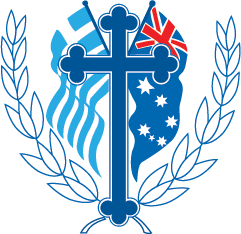The first Greek settlers who arrived in Western Australia before 1900 found life to be both hostile and different to that of their original homeland. The language and culture were also alien to them, often enhancing problems of loneliness and isolation. To add to their anxieties, no organisation existed to help reduce the shock of transition for these early Greeks settlers. For Greeks, the institution that could best serve this purpose and help them to maintain their Greek language, customs, traditions, and religion, was the Greek Orthodox Church.
For a time, priests from the Eastern States, such as Fathers Phocas and Kantopoulos, made regular trips to Perth to fulfill the spiritual needs of the local Greek population i.e. liturgies, weddings and christenings; often conducting these services in the homes of Perth’s Greeks.
September 1923 saw the formation of the Hellenic Community of Western Australia (HCWA). This organisation took over the pan-Hellenic responsibilities from the Castellorizian Association and its primary concern became that of building an Orthodox church in Perth. The Hellenic Community of WA was incorporated one year later, 9 September 1924. Rule 2 of the original 1924 Constitution stated that: “The object of the Association is the erection of a Greek Orthodox Church, Greek school and the improvement of the religious, moral, mental and social conditions of its members."
Fulfilling the religious and moral aspect of original constitution, the Hellenic Community carried on attempting to erect a Greek Orthodox church in Perth. The Castellorizian Association had already purchased in 1922 land along Parker Street in Northbridge; the vacant lot upon which the church would be erected.
To make possible the purchase of vacant land on Parker Street and then help finance the construction of a hall and church, many fundraising activities were organised. Concerts, bazaars, actions, and afternoon teas were conducted to collect funds. The women of the Greek community played a significant role in these activities as did John Aris who organised concerts throughout the 1920s and 1930s to raise funds so that a church could be constructed.
On the 24th July 1924, Metropolitan C. Knetes conducted the ceremony of blessing the foundation stone of the church. The honour of laying the foundation stone was given to Mrs. J. Michelides and Mrs. T. Kalafatas, two respected elders of the community.
However, the Hellenic Community decided to build a hall before the church as this was a more financially attainable goal. The Hellenic Hall was completed in 1925 and served as both a religious venue and social venue from which funds could be gathered and used to finance a suitable church building.
The Depression stalled the Hellenic Community's fundraising activities throughout the early 1930's yet by 1934, with the worst of the depression over, economic stability returned to Western Australia. The Hellenic Community was then successful in pooling together the resources of various Greek bodies and fraternities to assist in a final drive to raise monies for the church.
In late 1935 architect plans for a church had been drawn. A local Greek artist, Vlase Zanalis, was commissioned to paint the bare altar screen (iconostasis) with religious works and small icons. By December 1936 much of this had been accomplished and the Hellenic Hall finally had its dual role ended.
On Sunday 18th April 1937, the consecration ceremony for the Greek Orthodox Church of Saints Constantine and Helene was performed, conducted by Archbishop Timotheos Evangelinides.
The church quickly became an integral feature of the lives of many Greek families and a distinct landmark within Perth. A whole new chapter of spiritual, cultural, social, and even economic development for Perth’s Greeks was now possible. The church of Saints Constantine and Helene embodying not only our religious beliefs and customs, but our heritage and national identity.
A few decades later, on 21st May 1972, the Church of Saint's Constantine and Helene was proclaimed a Cathedral.
With post World War II migration increasing settler numbers, the HCWA continued to grow, along with new associations and venues. As a subgroup of the HCWA, the Hellenic Youth Association (HYA) was one such organisation which flourished during the 1950s, 60s and 70s. A host of sporting bodies fell under its umbrella.
In 1952, Tower House at 115 Francis Street was purchased. The initial intention was that the premise would serve as offices for the HCWA. It soon became the residence of the priest. The rectory also served as the HCWA’s afternoon Greek school for many years. By the early 1980s, it became a rental asset for the HCWA.
During 1968, the Hellenic Hall was demolished to make way for a new modern and larger complex, the Hellenic Community Centre, which opened in August 1969. Earlier, land had been purchased along Parker Street to accommodate the larger structure.
By the final decade of the twentieth century, the HCWA had moved into the provision of mainstream education and aged care for Perth’s Greek community. Land purchased in what was then Mirrabooka, now Dianella, became the site for the state’s only Greek day school, St Andrew’s Grammar. Next door, an aged care facility, originally known as Villa Hellas, was built. During the 1990s and 2000s both entities grew with new buildings and amenities added to the school and Hellenic Community Aged Care. Both facilities complement the HCWA’s near 100-year role of maintaining Hellenism in WA.
Dr John N Yiannakis OAM
For further information see: R. Appleyard and J. Yiannakis, Greek Pioneers in Western Australia (2002); and J. Yiannakis, Odysseus in the Golden West (2009).

